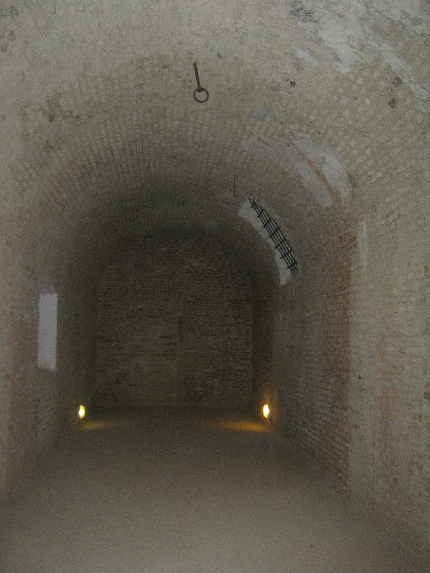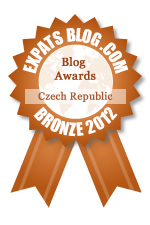
Sv Jakuba / Church of St James, Brno © Ricky Yates
As I explained in my previous post, we spent the last weekend of our recent holiday, in Brno, the second-largest city in the Czech Republic. Brno is just over 200 kilometres south-east of Prague and is situated at the confluence of the Svratka and Svitava rivers. With a population of about 400,000, the city is about one third of the size of the Czech capital.
Within the historic centre of Brno, there are a whole variety of different Churches. The one pictured on the left here, is dedicated to Sv Jakuba / St. James and is a fine example of baroque architecture. According to my ‘Brno City Guide’, the top of the spire is 92 metres high.
We were pleased to be able to walk around the interior of the Church and observe the very high pillars which in turn, support a fine vaulted roof. Being a Church dedicated to St. James, we were not surprised to find a photographic display of a group of parishioners who had made the pilgrimage to Santiago de Compostela a few years previously. But they clearly had started walking to Santiago at some point in Spain, unlike their mediaeval forebears, whose pilgrimage would, no doubt, have begun at the west door of this Church!

Cervený kostel /Red Church, Brno © Ricky Yates
The Church pictured on the right is known as Cervený kostel or in English as ‘The Red Church’. It is one of several similar red brick Churches that can be found in various parts of the Czech Republic, all dating from the second half of the nineteenth century. They were built following a ‘Toleration of Protestants’ act of the Austro-Hungarian Empire in the 1850s, which for the first time allowed protestant groups to build and own church buildings which actually looked like Churches with towers or spires and bells.
When first built, this Church was used for worship by German-speaking Lutherans. There was a large German-speaking population in Brünn, (as German-speakers still call Brno), until the expulsion of the Sudetendeutsche in 1945 following the end of the Second World War. It now belongs to the Evangelical Church of Czech Brethren, the largest Protestant denomination in the Czech Republic who came into being in December 1918, when the Czech-speaking Lutheran Church amalgamated with the Czech-speaking Presbyterian/Reformed Church.
Below is pictured the Roman Catholic Cathedral Church of St. Peter and St. Paul. Although situated on the site of previous Churches dating from the thirteenth and fourteenth centuries, the building obtained its current Neo-Gothic appearance when it was reconstructed in the early years of the twentieth century.

The Cathedral Church of St. Peter & St. Paul, Brno © Ricky Yates

Entrance to Špilberk Castle, Brno © Ricky Yates
Immediately west of the historic centre of Brno, is a rocky outcrop on which stands Hrad Špilberk / Špilberk Castle. Founded in the second half of the thirteenth century, the castle has been altered, extended and rebuilt many times since. It also has a chequered history, (please excuse the pun), which in many ways, reflects the experience of the Czech people over the centuries. One of its many claims to fame is resisting a siege lasting four months, by Swedish troops in 1645, thus changing the eventual outcome of the Thirty Years War.
The fortifications are impressive which I hope will be well illustrated by the photograph below. At various times Špilberk Castle has been both a prison and a military barracks. Since 1960, it has been part of Brno City Museum and we spent most of our Saturday afternoon in Brno, visiting two different exhibitions within the castle – one explaining the numerous centuries of central European history – the other, a wonderful collection of art work from the late nineteenth century through to the beginning of the Second World War.

The fortifications of Špilberk Castle © Ricky Yates
Below are two photographs that I took when exploring the castle complex. One shows the depth of the moat that surrounds the central part of the castle. The other shows part of the casements, a series of rooms constructed within the castle walls which have been used over time as both prison cells and for the storage of military armaments.
 Moat of Špilberk Castle, Brno © Ricky Yates |
 Casement within Špilberk Castle, Brno © Ricky Yates |

Decorated building in Brno © Ricky Yates
Just as in Prague, it is possible to walk the streets of the historic centre of Brno, and see a whole variety of different styles of architecture and artistic decoration on the exterior of buildings. This one photograph doesn’t do justice to the wealth and variety that there is to be seen.

Historic tram in Brno © Ricky Yates
Likewise as in Prague, Brno has an excellent public transport network including many trams. At weekends, this historic tram runs along a central circuit, a reminder of how public transport used to be many decades ago.
Over the weekend, we enjoyed the company and hospitality of our friends Lynsey and Johnny who walked around with us all day on Saturday 28th July. Late in the afternoon, they took us for some well-earned drinks at one of their favourite Brno cafés.

Lynsey & Johnny relaxing in a Brno café © Ricky Yates
As you can see, Johnny’s friend Pfeffer, who travels around with him in his shoulder bag, took a fancy to my beer 🙂

Pfeffer enjoying my beer! © Ricky Yates



Istanbul has a historic tram on Istiklal Caddessi that looks just like the Brno tram, only it is painted red. They must date from the same time period.
They probably do Karen – Does the one in Istanbul still run or is it a stationary exhibit like the one sitting in the middle of Wenceslas Square in Prague?
Super post, Ricky. You really give your readers a very good impression of this interesting city. The photo of the fortifications reminds me of walking past the ramparts of Prague Castle one sunny afternoon during my first visit.
Thank you for your compliments Perpetua – I really struggled to get this post completed, particularly deciding what to include or not include. Glad that it brought back some more good memories for you.
Ricky, the tram in Istanbul was running some years ago when I was there. I guess it still does, because it was a big tourist attraction.
As for Czech, I’ve only been in Prague, but this post and images made me curious about this city. A weekend (or a week) with beer drinking and sightseeing would do the trick. And the autumn temperature in Czech is much better than here in Norway!
Yes, it still runs. It’s quite useful when late for an appointment – like church!
Hello – St. James Church/ sv. Jakub Church is in Gothic style! Side altars are baroque…
Hello to another Katka! Yes – you are correct in saying that the main nave is Gothic, to be more specific – Late Gothic. But the interior is very baroque in style & not just the side altars!
A little clarification of the Protestant Toleration Patent. In 1781 Joseph II. issued what is known as the Toleration Patent, which did what it says on the tin: certain religions/denominations other than Roman Catholic were tolerated, and just tolerated (but still that was a huge thing). Which meant such things like the fact that their churches had to be built at the outskirts and not look like churches (no towers, no bells). Then, in 1861, what is called the Protestant Patent was issued, and since then these churches that look like churches could be built.
And isn’t the Red Church just impossible to photograph? Even when it’s so strategically placed?
BTW, to the Brno accent thing that was touched upon in the comments under the rivalries post: it’s more pronounced with older people, especially outside the centre. There are many students from different parts of the Czech Republic, or even Slovakia, in Brno. And many people who studied in Brno now live there, like my brother-in-law who actually comes from Prague… But the Brno accent definitely exists. I just cannot describe it, because I’m generally bad at distinguishing the little nuances in accents. In this case, I just hear it and know.
Hello Hana – Thank you for this greater detail which I did know but didn’t put into the original blogpost. The earlier Toleration Patent did result in Protestant Churches being located on the edge of villages & towns &, as you say, not necessarily looking like Churches. And I concur entirely with your comment about the difficulty of photographing the Red Church in Brno.
I stand by my earlier reply to the comment about the ‘Brno accent’. I’ve never distinguished it but I’m sure, as you say, that it does exist.